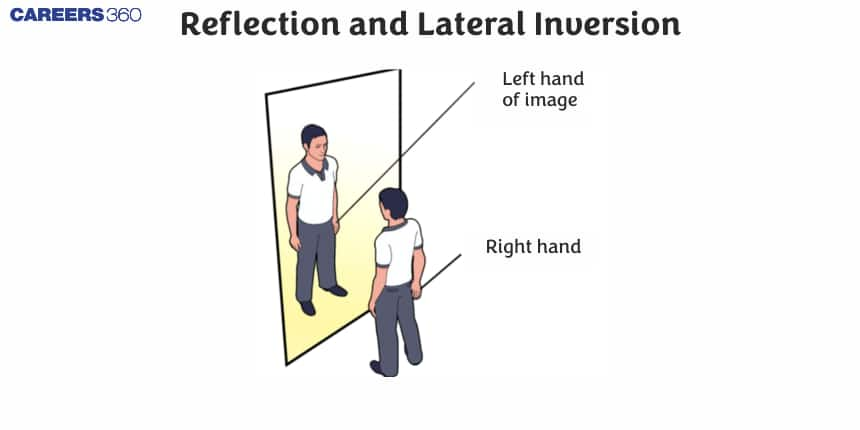Reflection and Lateral Inversion
Have you ever looked into a mirror or a calm pond and seen your reflection staring back at you? This happens because of the reflection of light when light rays hit a smooth surface and bounce back to your eyes. But the image you see is not exactly the same as you, it is flipped from left to right. This effect is called lateral inversion. Together, reflection and lateral inversion explain how mirrors form clear, upright but reversed images. Smooth surfaces like mirrors and still water reflect light evenly, letting you see yourself clearly, while rough surfaces scatter light in many directions, which is why they don’t show reflections. In this article you will learn about the reflection, types of reflection, use of reflection and lateral inversion. This topic is very important for boards as well as for competitive exams like JEE and NEET.
This Story also Contains
- What is Reflection?
- Reflection Through a Plane Mirror
- What is lateral inversion?

Also read -
What is Reflection?
Reflection is the phenomenon in which light bounces back after striking a smooth and shiny surface, like a mirror.
The image formed by reflection appears due to the change in the direction of light.
There are two types of reflection:
- Regular Reflection: When light falls on a smooth surface and reflects in a fixed direction.
- Diffuse Reflection: When light falls on a rough surface and scatters in many directions.
Reflection Through a Plane Mirror
Plane Mirror:
A plane mirror is a flat and smooth reflective surface that reflects light to form clear images.
Reflection:
When light rays strike a plane mirror, they bounce back following the law of reflection:
- Angle of Incidence = Angle of Reflection
- The incident ray, reflected ray, and normal all lie in the same plane
Image Formation:
- The image formed by a plane mirror is virtual, meaning it cannot be projected on a screen.
- The image is upright and of the same size as the object.
- The image appears behind the mirror at the same distance as the object in front.
- Lateral inversion occurs left and right sides are interchanged.
Applications of Reflection
- Mirrors are used in bathrooms, dressing tables, and vehicles to see clear images.
- Periscopes in submarines and tanks help view objects not in direct sight.
- Kaleidoscopes use mirrors to create symmetrical patterns.
- Telescopes, microscopes, and cameras use mirrors to form images.
- Mirrors are used in interior decoration to make spaces brighter and larger.
- Rearview and side mirrors in vehicles help drivers see traffic behind them.
What is lateral inversion?
Definition: Lateral inversion is the left-right reversal of an image formed by a plane mirror. In other words, the image appears flipped horizontally, though the top and bottom remain the same.
Example:
- When you raise your right hand, your mirror image appears to raise its left hand.
- Words like “POLICE” on vehicles appear reversed in mirrors, which is why the text is often written in reverse on ambulances for drivers to read it in their mirrors.
Uses of Lateral Inversion:
- Ambulances and emergency vehicles: Words like “AMBULANCE” are written in reverse so drivers see them correctly in their mirrors.
- Rearview and side mirrors of vehicles: Help drivers judge the position of other vehicles correctly.
- Funhouse mirrors and magic mirrors: Used to create interesting visual effects in amusement parks.
- Optical instruments: Help in correcting the orientation of images in devices like periscopes and telescopes.
Related Topics,
- Angle of Incidence
- Reflection of Light
- Refraction and Dispersion of Light through a Prism
- Refraction of Light
- Refractive Index
Also, check-
- NCERT Exemplar Class 11th Physics Solutions
- NCERT Exemplar Class 12th Physics Solutions
- NCERT Exemplar Solutions for All Subjects
NCERT Physics Notes:
Frequently Asked Questions (FAQs)
Due to how we perceive the mirror image, we perceive the left and right as reversed (lateral inversion). It is referred to as Lateral Inversion when the left image becomes the right image in a mirror, and vice versa.
Latitudinally inverted images are known as lateral inversions. Due to the fact that the image of an object in a plane mirror lies both as far behind the mirror as the object is in front of it, a lateral inversion occurs due to them facing each other.
From the object, light rays are reflected on the plane mirror, reaching the eyes. It appears to our brain at this point that the reflected ray comes from within the mirror. It appears that the object is literally inverted for this reason.
Using a plane mirror, lateral inversion reverses the images left to right. A plane mirror allows us to observe our images in order to determine our left side is to the right of the image and our right side is to the left of the image.
1) Ambulances have the word AMBULANCE inverted left-right on the side so that the driver of a vehicle in the front viewing the back-view mirror can immediately recognize the word AMBULANCE while giving way.
2) A mirror can also be used to form an image.
3) someone can see the image in your eyes if they look at your lateral inversion